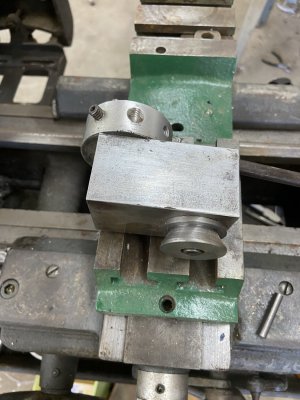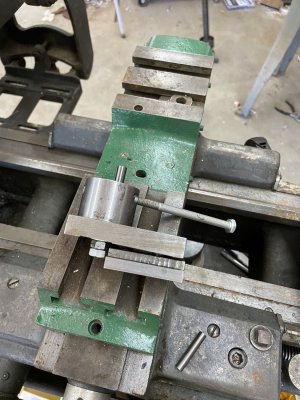- Joined
- Apr 23, 2013
- Messages
- 1,095
RexAfter speaking with Jim a bit, here's what his design looks like for his super-simple ball turner with fixed radii that you can make from scrap and attach to any compound:
View attachment 454681
(view from the back of the lathe)
The parts are a tee-nut base, a swivel puck, a handle, a cutter (worn out end mill or whatever), some set screws, a long screw (sized to fit the radii you need) and a couple nuts. The tee-nut should be slightly proud of the compound top.
Since most of us have our compounds semi-permanently mounted, this design conveniently fits in the tee slot of the compound. Four set screws secure it in the slot securely.
The swivel puck is just a piece of CRS of convenient size. Drill and (optionally) ream a hole that's a fairly precise fit for a socket-head cap screw through the swivel base and the end of the tee-nut, then capture the swivel base with a cap screw and two nuts (one to adjust the tightness and another as a lock nut).
Find an old worn out end mill or whatever to use as a cutter, and grind one end perfectly flat and perpendicular to the sides. You want a sharp edge all the way around the circular top of the cutter.
Drill and (optionally) ream a hole the same size as the cutter through the cylindrical swivel exactly the desired radius from the center of the cylinder minus the radius of the cutter you chose. I thought this had to be a blind hole to bear against the cutting forces. A flat bottomed hole exactly the right depth to position the cutter at center height would be a PITA to make, but Jim says a grub screw in the side is more than sufficient to bear the cutting forces and is a whole lot easier to adjust.
Finally, mill a flat at an angle and drill and tap a hole for a handle at a convenient location (or three).
Notes from our conversation:
I'll be making one of these over the coming days, and probably remaking some of the umpteen ball handles on my Quorn (just two radii required). I'll post an update if I learn anything new.
- This has a zero rake angle and no relief. This is not an issue in practice (witness Jim's video above). It's basically a tangential turning tool for already cylindrical stock, but it won't work for for facing. Since the cutter is at or slightly below center height, you don't need any relief (the work itself already falls away).
- The zero rake angle is actually fine for even harder materials, but the lack of any chip breaker can make for some scary chips. But only the final pass will stay in contact with the entire sphere (and since you're swinging the handle manually I imagine it's easy to break chips like pecking while drilling).
- Note that the swivel puck diameter and thickness affects the maximum diameter ball that can be turned. When you feed in enough on the cross slide to make the final pass at the final sphere radius, the puck must not interfere with the bottom of the work.
- In use, the cutter is behind the axis of rotation, of course, but you want the handle attached to the right so that you can cut almost a complete sphere (or as narrow a shaft as you like for ball handles).
- Of course, there is nothing preventing you from drilling holes at multiple different radii!
- Jim is the master of keeping things simple. He points out that we usually don't need a tool with a continuously adjustable radius. We just need a tool that can cut the radius we need RIGHT NOW. In practice, how many different sizes do we really need? If you don't have a puck with the radius you need, just drill another hole in one at the correct offset and drill and tap another hole in the side for another grub screw. In my case, I'm mostly putting a relatively small ornamental ball at the end of a lever, so the size isn't particularly critical anyway. I've no need for turning 6" spheres.
I'll also be posting another thread on how Jim makes and polishes/laps his radius form tools. As usual, super simple and effective.
Your picture shows the radius tool extending from the radius axis not the radius swing distance from the radius axis. And if you could make the tee nut base part a different color it would make it easier to visualize. I will see if I can send you a picture of this latter today.
jimsehr











